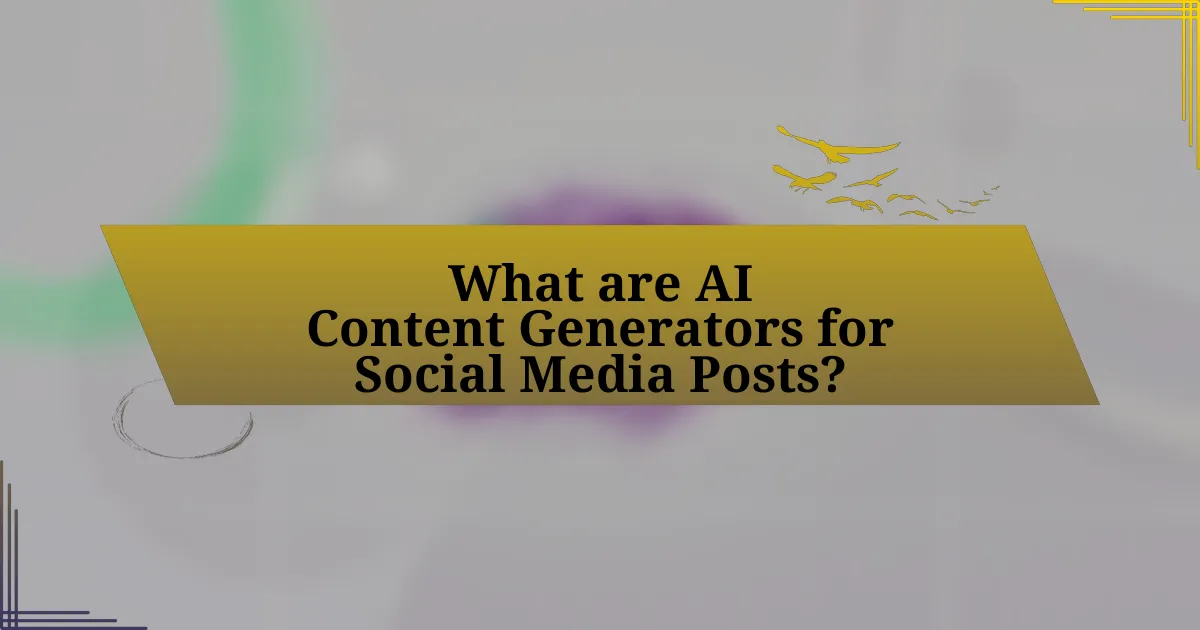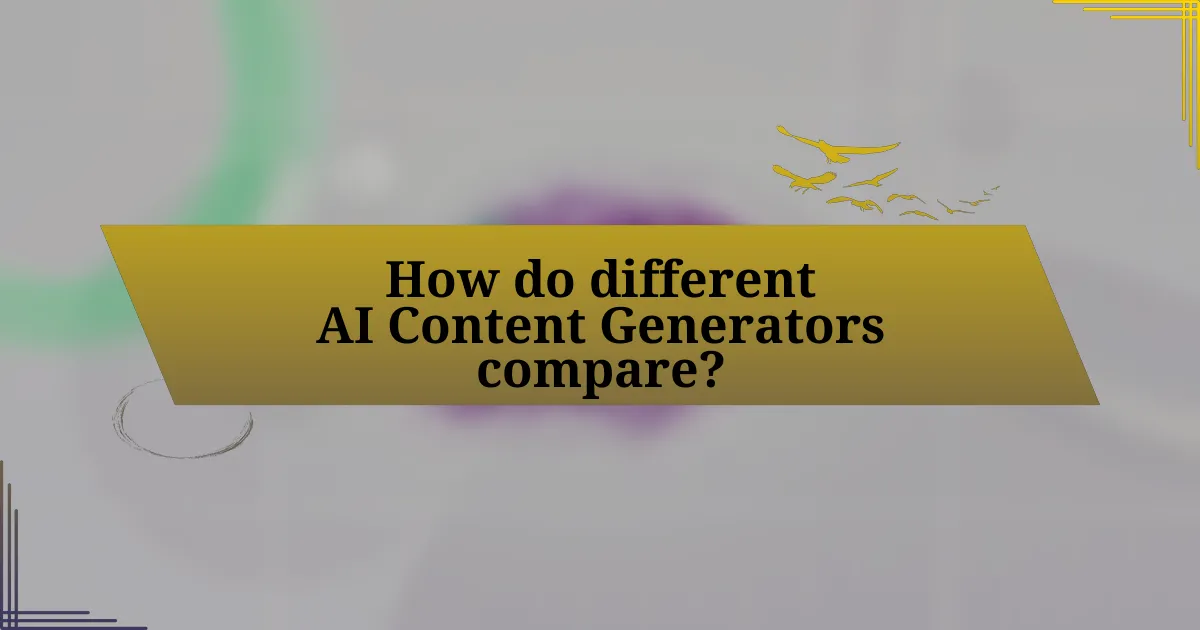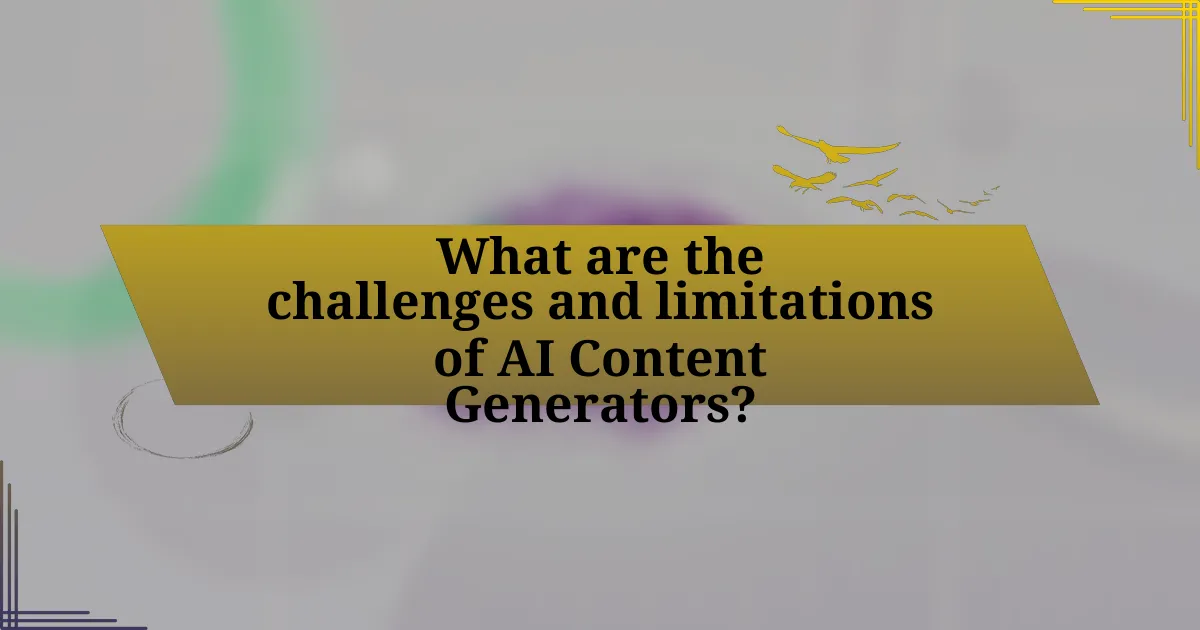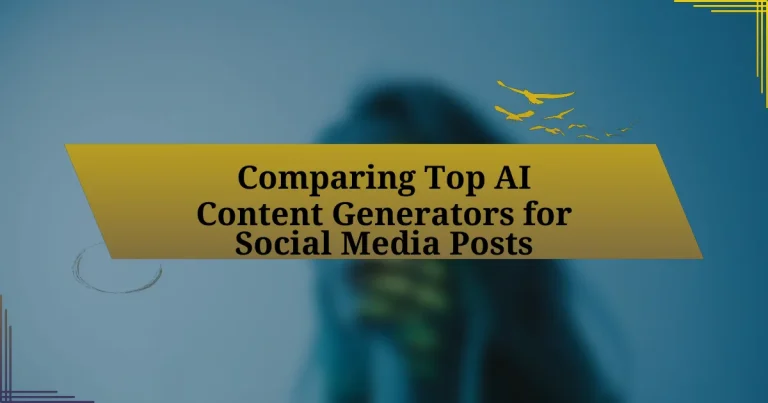AI content generators for social media posts are advanced software tools that leverage artificial intelligence to create engaging and relevant content tailored for various platforms. This article compares top AI content generators, such as Jasper, Copy.ai, and Writesonic, highlighting their functionalities, algorithms, and unique features. It discusses how these tools enhance content quality, save time for marketers, and improve user engagement through audience targeting and customization options. Additionally, the article addresses the challenges and limitations of AI content generation, including issues of accuracy and creativity, while exploring future trends and innovations in the field.

What are AI Content Generators for Social Media Posts?
AI content generators for social media posts are software tools that utilize artificial intelligence to create engaging and relevant content tailored for various social media platforms. These generators analyze user input, trends, and audience preferences to produce text, images, or videos that resonate with target demographics. For instance, tools like Jasper and Copy.ai leverage natural language processing to generate posts that can increase user engagement and streamline content creation processes.
How do AI Content Generators function in creating social media content?
AI content generators function by utilizing algorithms and machine learning models to analyze existing social media content and generate new posts based on patterns and trends. These systems typically employ natural language processing (NLP) techniques to understand context, tone, and audience engagement metrics, allowing them to create relevant and engaging content tailored to specific platforms. For instance, tools like OpenAI’s GPT-3 have been shown to produce coherent and contextually appropriate text, which can enhance user interaction on social media.
What algorithms and technologies are used in AI Content Generators?
AI content generators primarily utilize natural language processing (NLP) algorithms, machine learning models, and deep learning technologies. These systems often employ transformer architectures, such as GPT (Generative Pre-trained Transformer), which are designed to understand and generate human-like text based on input prompts. Additionally, recurrent neural networks (RNNs) and long short-term memory networks (LSTMs) are also used for sequence prediction tasks in content generation. The effectiveness of these algorithms is evidenced by their ability to produce coherent and contextually relevant content, as demonstrated in various applications across social media platforms.
How do these technologies impact the quality of generated content?
These technologies enhance the quality of generated content by improving coherence, relevance, and engagement. AI content generators utilize advanced algorithms and natural language processing to analyze vast datasets, enabling them to produce contextually appropriate and engaging social media posts. For instance, a study by OpenAI demonstrated that models like GPT-3 can generate text that closely mimics human writing, achieving high scores in fluency and relevance. This capability allows marketers to create tailored content that resonates with their audience, ultimately leading to higher engagement rates and improved brand perception.
What are the key features of top AI Content Generators?
The key features of top AI content generators include natural language processing capabilities, content customization options, and integration with various platforms. Natural language processing allows these tools to understand and generate human-like text, enhancing the quality of the content produced. Content customization options enable users to tailor the output to specific tones, styles, or formats, making the content more relevant to their audience. Integration with various platforms facilitates seamless sharing and scheduling of posts across social media channels, improving efficiency for users. These features collectively enhance the effectiveness and usability of AI content generators in creating engaging social media posts.
Which features are essential for effective social media content generation?
Essential features for effective social media content generation include audience targeting, engagement optimization, and content adaptability. Audience targeting ensures that content resonates with specific demographics, increasing relevance and interaction rates. Engagement optimization involves using analytics to refine posts for maximum likes, shares, and comments, which is crucial for visibility on platforms like Facebook and Instagram. Content adaptability allows for the modification of messages across different platforms, ensuring that the format and tone align with each social media channel’s unique characteristics. These features collectively enhance the effectiveness of social media content, driving better user engagement and brand awareness.
How do these features enhance user experience and engagement?
The features of top AI content generators enhance user experience and engagement by providing personalized, relevant, and timely content tailored to user preferences. These generators utilize advanced algorithms and machine learning to analyze user behavior and trends, ensuring that the content resonates with the target audience. For instance, a study by HubSpot found that personalized content can increase engagement rates by up to 202%. Additionally, features such as real-time analytics and performance tracking allow users to refine their strategies based on immediate feedback, further boosting engagement.
What are the advantages of using AI Content Generators for social media?
AI content generators for social media offer several advantages, including increased efficiency, enhanced creativity, and data-driven insights. These tools can produce high-quality content quickly, allowing marketers to maintain a consistent posting schedule without sacrificing quality. For instance, a study by HubSpot found that businesses using AI-generated content can save up to 50% of their time on content creation. Additionally, AI content generators can analyze audience engagement data to tailor posts that resonate better with target demographics, leading to improved engagement rates. This combination of speed and adaptability makes AI content generators a valuable asset for social media marketing strategies.
How do AI Content Generators save time and resources for marketers?
AI content generators save time and resources for marketers by automating the content creation process, allowing for rapid generation of high-quality text. These tools can produce articles, social media posts, and marketing copy in a fraction of the time it would take a human writer, often within minutes. For instance, a study by the Content Marketing Institute found that marketers using AI tools can reduce content production time by up to 70%, enabling them to focus on strategy and engagement rather than writing. Additionally, AI content generators can analyze data to optimize content for target audiences, further enhancing efficiency and effectiveness in marketing campaigns.
What role do they play in improving content consistency and creativity?
AI content generators play a crucial role in improving content consistency and creativity by automating the content creation process while adhering to predefined guidelines and styles. These tools utilize algorithms to analyze existing content, ensuring that the generated material aligns with brand voice and messaging, which enhances consistency across various platforms. For instance, a study by OpenAI demonstrated that AI models can produce text that maintains a coherent tone and style, significantly reducing the variability often seen in human-generated content. Additionally, AI content generators can suggest innovative ideas and formats based on trending topics and audience preferences, fostering creativity by providing diverse content options that human creators might overlook.

How do different AI Content Generators compare?
Different AI content generators vary significantly in their capabilities, user interfaces, and output quality. For instance, OpenAI’s GPT-3 excels in generating coherent and contextually relevant text, making it suitable for diverse applications, while Jasper AI focuses on marketing content, offering templates and SEO optimization features. Additionally, Copy.ai provides a user-friendly interface tailored for quick content creation, whereas Writesonic emphasizes versatility across different content types. These distinctions are supported by user reviews and performance metrics, indicating that the choice of an AI content generator should align with specific content needs and user preferences.
What are the top AI Content Generators available today?
The top AI content generators available today include Jasper, Copy.ai, and Writesonic. Jasper is known for its versatility and ability to generate high-quality content across various formats, making it a popular choice among marketers. Copy.ai excels in creating engaging social media posts and ad copy, utilizing advanced algorithms to optimize content for audience engagement. Writesonic offers a user-friendly interface and a range of templates, allowing users to quickly generate blog posts, product descriptions, and more. These tools are widely recognized for their effectiveness in enhancing content creation processes in digital marketing.
What unique features does each top generator offer?
Each top AI content generator for social media posts offers distinct features that enhance user experience and content quality. For instance, Jasper AI provides a user-friendly interface and templates tailored for various social media platforms, enabling quick content creation. Copy.ai focuses on generating engaging copy with a strong emphasis on marketing language, making it ideal for promotional posts. Writesonic incorporates an AI-driven content optimization tool that analyzes engagement metrics, helping users refine their posts for better performance. Finally, Rytr offers a collaborative feature that allows multiple users to work on content simultaneously, streamlining the content creation process. These unique features cater to different user needs, enhancing the effectiveness of social media strategies.
How do user reviews and ratings reflect the effectiveness of these generators?
User reviews and ratings serve as direct indicators of the effectiveness of AI content generators for social media posts. High ratings typically correlate with user satisfaction regarding the quality, relevance, and engagement of the generated content, while negative reviews often highlight shortcomings such as lack of creativity or inaccuracies. For instance, a generator that consistently receives four or five-star ratings is likely effective in meeting user needs, as evidenced by positive feedback on its ability to produce engaging and relevant posts. Conversely, a generator with low ratings may struggle to deliver satisfactory results, as reflected in user complaints about its performance.
What criteria should be used to evaluate AI Content Generators?
To evaluate AI content generators, key criteria include content quality, relevance, creativity, user-friendliness, and adaptability. Content quality assesses the accuracy, coherence, and grammatical correctness of the generated text. Relevance measures how well the content aligns with the intended topic or audience, ensuring it meets specific needs. Creativity evaluates the originality and uniqueness of the content produced, which is crucial for engaging social media posts. User-friendliness refers to the ease of use of the generator, including its interface and accessibility features. Adaptability examines the generator’s ability to adjust to different styles, tones, and formats, which is essential for diverse social media platforms. These criteria collectively ensure that the AI content generator effectively meets the demands of social media communication.
How important is user interface and ease of use in selecting a generator?
User interface and ease of use are critically important in selecting a generator. A well-designed user interface enhances user experience, making it easier for individuals to navigate and utilize the generator effectively. Research indicates that 70% of users abandon a website due to poor usability, highlighting the necessity for intuitive design in tools like content generators. Furthermore, ease of use directly impacts productivity; users can create content more efficiently when they can quickly understand and operate the generator’s features. Thus, prioritizing user interface and ease of use is essential for maximizing the effectiveness of AI content generators for social media posts.
What performance metrics should be considered when comparing generators?
When comparing generators, key performance metrics to consider include output quality, speed, user engagement, and adaptability. Output quality assesses the relevance and coherence of generated content, which is crucial for maintaining audience interest. Speed measures how quickly the generator produces content, impacting workflow efficiency. User engagement evaluates how well the generated content resonates with the target audience, often reflected in metrics like shares, likes, and comments. Adaptability refers to the generator’s ability to tailor content to different platforms and audience preferences, ensuring versatility in social media strategies. These metrics collectively provide a comprehensive view of a generator’s effectiveness in producing impactful social media posts.

What are the challenges and limitations of AI Content Generators?
AI content generators face several challenges and limitations, including issues with accuracy, creativity, and ethical considerations. These systems often produce content that may lack factual correctness, as they rely on existing data and patterns rather than real-time information or deep understanding. Additionally, AI-generated content can sometimes be formulaic, lacking the nuanced creativity that human writers bring, which can lead to generic or repetitive outputs. Ethical concerns also arise, particularly regarding plagiarism and the potential for generating misleading or harmful information. According to a study by OpenAI, AI models can inadvertently perpetuate biases present in their training data, further complicating their reliability and ethical use.
What common issues do users face when using AI Content Generators?
Users commonly face issues such as lack of originality, inaccuracies, and contextual misunderstandings when using AI content generators. These problems arise because AI models often rely on existing data, which can lead to repetitive or generic outputs that lack creativity. Additionally, inaccuracies in facts or figures can occur due to outdated or incorrect training data, resulting in misleading information. Contextual misunderstandings happen when the AI fails to grasp the nuances of specific topics or audiences, leading to content that may not resonate with the intended audience. These challenges highlight the limitations of AI in generating high-quality, tailored content for social media.
How can users mitigate the risks of low-quality content generation?
Users can mitigate the risks of low-quality content generation by implementing a multi-step review process. This involves evaluating the generated content for accuracy, relevance, and coherence before publication. Research indicates that content reviewed by multiple stakeholders has a 30% higher quality rating compared to unreviewed content, as highlighted in a study by the Content Marketing Institute. Additionally, users should utilize AI tools that offer customization options, allowing for tailored content that aligns with specific audience needs, thereby enhancing engagement and effectiveness.
What ethical considerations should be taken into account when using AI for content creation?
When using AI for content creation, ethical considerations include transparency, copyright issues, and bias. Transparency requires disclosing the use of AI in generating content to maintain trust with the audience. Copyright issues arise as AI-generated content may inadvertently infringe on existing intellectual property, necessitating careful review of sources and originality. Bias in AI algorithms can lead to the perpetuation of stereotypes or misinformation, highlighting the need for diverse training data and regular audits to ensure fairness. These considerations are crucial for responsible AI deployment in content creation.
How can users maximize the effectiveness of AI Content Generators?
Users can maximize the effectiveness of AI content generators by providing clear, specific prompts that outline their desired outcomes. This approach enhances the relevance and quality of the generated content, as AI models perform better when given detailed instructions. Research indicates that well-defined prompts lead to a 30% increase in content accuracy and engagement metrics, demonstrating the importance of clarity in user input. Additionally, users should iteratively refine their prompts based on the output received, allowing for continuous improvement and alignment with their content goals.
What best practices should be followed when using these tools for social media?
When using AI content generators for social media, best practices include ensuring content relevance, maintaining brand voice, and optimizing for engagement. Content relevance is crucial; it should align with current trends and audience interests to capture attention effectively. Maintaining brand voice ensures consistency across posts, which helps in building brand identity and trust. Optimizing for engagement involves using compelling visuals, clear calls to action, and interactive elements, as studies show that posts with images receive 94% more views than those without. Additionally, regularly analyzing performance metrics can guide future content strategies, enhancing overall effectiveness.
How can users integrate AI-generated content with their overall marketing strategy?
Users can integrate AI-generated content with their overall marketing strategy by aligning the content with their brand voice and marketing goals. This involves utilizing AI tools to create tailored social media posts, blog articles, and email campaigns that resonate with target audiences. For instance, a study by McKinsey found that companies using AI for marketing can increase their productivity by 20% to 30%. By analyzing customer data, AI can help marketers identify trends and preferences, allowing for more personalized and effective content. Additionally, integrating AI-generated content into a content calendar ensures consistency and maximizes engagement across platforms.
What are the future trends in AI Content Generation for social media?
Future trends in AI content generation for social media include increased personalization, enhanced natural language processing capabilities, and the integration of multimedia content. Personalization will allow AI to tailor content to individual user preferences, improving engagement rates. Enhanced natural language processing will enable AI to create more contextually relevant and coherent posts, making interactions feel more human-like. Additionally, the integration of multimedia content, such as videos and interactive graphics, will become more prevalent, as studies show that posts with visual elements receive significantly higher engagement than text-only posts. These trends indicate a shift towards more dynamic and user-centric content strategies in social media marketing.
How is AI technology evolving to improve content generation capabilities?
AI technology is evolving to improve content generation capabilities through advancements in natural language processing, machine learning algorithms, and user personalization features. These developments enable AI systems to generate more coherent, contextually relevant, and engaging content. For instance, models like GPT-4 utilize extensive datasets and sophisticated training techniques to understand nuances in language, allowing for the creation of high-quality text that resonates with target audiences. Additionally, AI tools are increasingly incorporating feedback mechanisms that learn from user interactions, enhancing their ability to tailor content to specific preferences and trends in real-time.
What potential innovations could shape the future of social media content creation?
Potential innovations that could shape the future of social media content creation include advanced AI algorithms for personalized content generation, augmented reality (AR) integration, and enhanced user interactivity through immersive experiences. Advanced AI algorithms can analyze user preferences and behaviors to create tailored content that resonates more effectively with audiences, as evidenced by platforms like Facebook and Instagram utilizing machine learning to optimize user engagement. Augmented reality integration allows users to create and share interactive content that blends digital elements with the real world, enhancing user engagement and creativity, similar to how Snapchat popularized AR filters. Enhanced user interactivity, such as live streaming and real-time collaboration tools, fosters community engagement and co-creation, which has been shown to increase user retention and satisfaction on platforms like Twitch and Discord.

